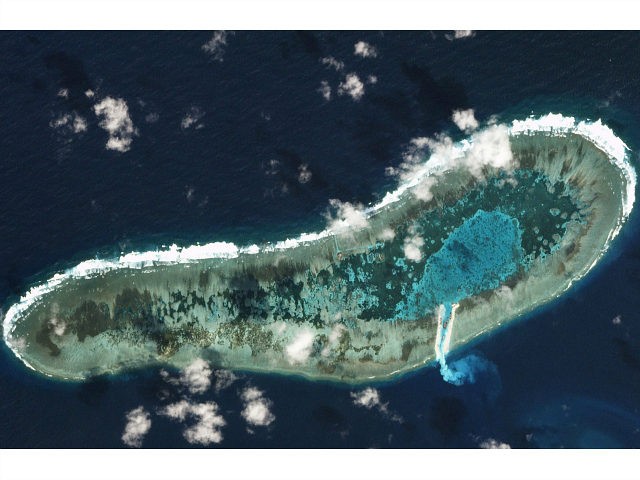With main objector Philippines placated, Vietnam is taking the mantle of opposition to China’s colonization of the South China Sea, with a new report indicating that it has begun dredging land in the Spratly Island chain.
Reuters reports that satellite images reveal a new dredging project in the Vietnamese Spratly Islands, apparently intended to convert Ladd Reef from a shifting tidal land mass to a sturdy island onto which Hanoi can build military and civilian assets. The reef is already home to a lighthouse, Reuters notes, but it “is completely submerged at high tide.” The dredging project appears designed to change this.
The Reuters report notes that, while Vietnam’s government did not respond to a request for comment on the new construction, China responded with another warning against Vietnam developing its sovereign territory. China, Foreign Ministry spokesman Lu Kang said, has “indisputable sovereignty over the Nansha [Spratly] islands, including Riji [Ladd] reef.” “We urge the relevant countries to respect China’s sovereignty and rights, end their illegal occupation and illegal operations, and not take any actions that may complicate the situation,” he added.
China claims most of the South China Sea, including the territories of Vietnam, Taiwan, the Philippines, Brunei, and Malaysia, as well as waters off the coast of Indonesia’s Natuna Island. In July, the Permanent Court of Arbitration at the Hague found China’s claims in the region invalid, and its massive island-building projects in the Spratly and Paracel Islands illegal. China responded by vowing to ignore the Hague completely.
That case, Philippines v. China, was the product of the foreign policy of former Philippine President Benigno Aquino. His successor, Rodrigo Duterte, has actively rejected the fight to protect the sovereignty of his country in the South China Sea, instead calling Chinese President Xi Jinping a “close friend” and temporarily banning Philippine fishermen from using the nation’s sovereign waters at China’s behest (China later lifted its restriction on Philippine fishing in the region).
In light of Manila’s pivot, Vietnam has emerged as the most formidable challenger to China’s colonization of the region. While both nations are run by their respecting Communist Parties, Vietnam has made clear it will continue to exercise its sovereignty over the territory China claims as its own. In August, shortly after reports of Chinese hackers placing pro-China South China Sea messages on Vietnam’s airport screens, satellite evidence revealed that Vietnam had moved rocket launchers into the disputed territory.
China has responded to the growing resistance to its presence in Vietnamese waters by issuing false statements that Vietnamese Prime Minister Nguyen Xuan Phuc supports their military projects in the South China Sea. Vietnamese officials denied China’s claims.
In November, the Center for Strategic and International Studies (CSIS) published satellite images showing the expansion of Vietnamese runways in the region, which would now allow the Vietnamese air force to employ more of its capabilities against any potential Chinese threat. “These new facilities can easily accommodate the Vietnamese air force’s PZL M28B maritime surveillance aircraft and CASA C-295 transport planes,” CSIS reported at the time. Vietnam has also sought to expand its military capabilities by buying American equipment after President Obama lifted a nearly half-century-old ban on such arms sales.

COMMENTS
Please let us know if you're having issues with commenting.